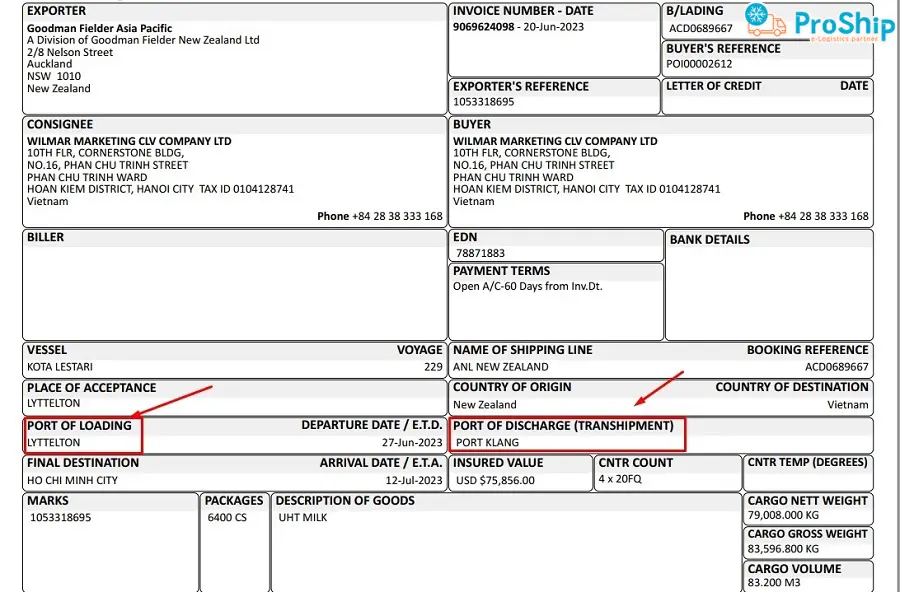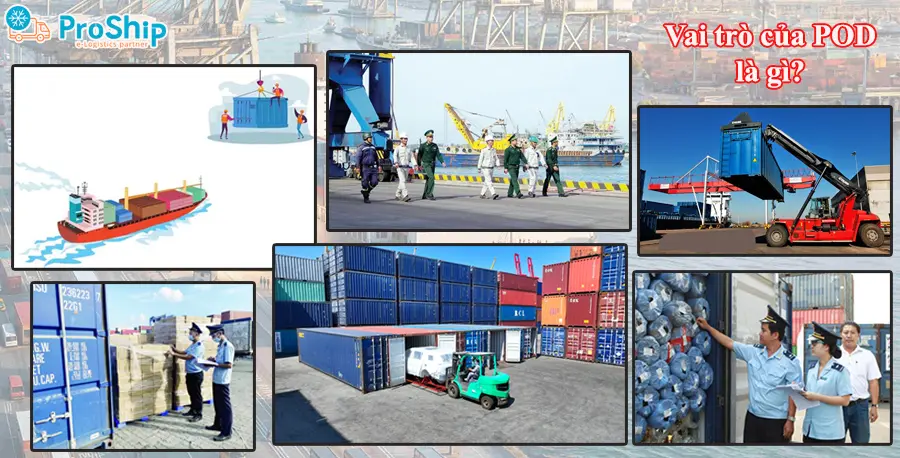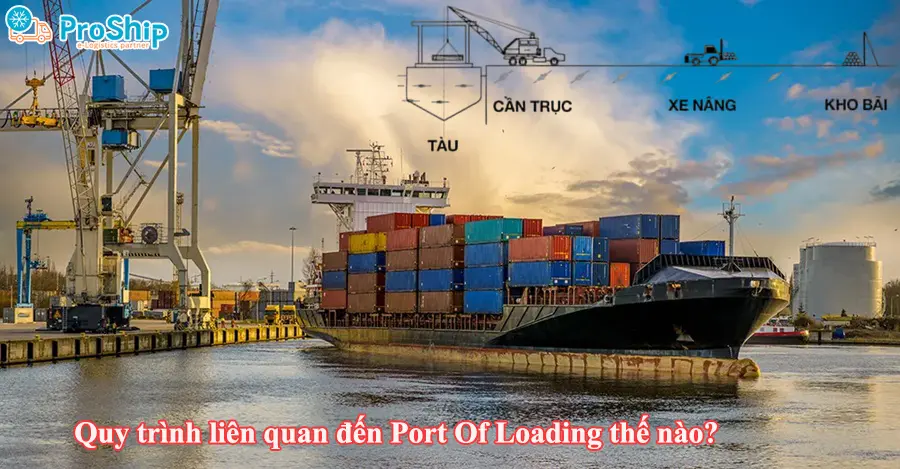x Bạn muốn tìm hiểu quy định liên quan cũng như vai trò của Port Of Discharge là gì trong xuất nhập khẩu?
x Doanh nghiệp bạn đã, đang và sẽ chọn hình thức vận chuyển hàng đường biển và cần biết về các loại cảng biển thông dụng, trong đó có POD?
x Bạn chưa biết các yếu tố ảnh hưởng tới POD là gì? Thiết bị, hệ thống sử dụng tại POD gồm những gì?
Port of discharge có thể hiểu là cảng trung chuyển…Proship.vn chúng tôi sẽ giải đáp nhanh thuật ngữ port of discharge là gì cũng như vai trò của cảng này là gì. Từ đây, các doanh nghiệp chuyên kinh doanh hàng xuất, nhập khẩu qua đường biển cũng có kinh nghiệm phân biệt, có sự hiểu biết nhất định về các loại cảng biển.
ĐỌC THÊM: Dịch vụ vận chuyển Container giá tốt
Port of discharge là gì?
Port of discharge là gì? POD (Port of Discharge) là thuật ngữ thường gặp trong vận đơn đường biển, là cảng dỡ hàng, cảng đích. Là nơi mà hàng hóa được dỡ xuống từ tàu biển hoặc phương tiện vận chuyển khác khi đến đích cuối cùng.

Đây là một phần không thể thiếu trong quy trình vận chuyển quốc tế, đóng vai trò xác định điểm đích đến cuối cùng, kết thúc hành trình của hàng hóa từ cảng đi (Port of Loading – POL) đến cảng đích.
Port of Discharge cũng là một hải cảng nhưng đóng vai trò là cảng dỡ hàng, cảng đích. Nhưng cũng là cảng đó, khi xếp hàng lên tàu thì nó đóng vai trò là cảng xếp hàng Port Of Loading – Cảng xếp hàng.
Hệ thống thiết bị tại Port of Discharge gồm những gì?
Thiết bị của port of discharge là gì? Cảng đích sẽ trang bị những thiết bị và hạ tầng để có thể quản lý hàng hóa và tàu biển. Những thiết bị phổ biến thường dùng tại port of discharge như:
- Xe nâng:
Loại xe này được sử dụng chủ yếu để xếp dỡ hàng, vận chuyển pallet hoặc hàng hóa không đóng gói trong cont ở khu vực bãi cảng;
- Cẩu cảng:
Là thiết bị dùng để dỡ hàng khỏi phương tiện vận tải biển hoặc container. Tùy đặc điểm từng cảng mà cẩu có thể là loại cố định hoặc di động;
- Hệ thống kiểm tra chất lượng:
Cảng đến sẽ có các thiết bị tiêu chuẩn như máy quét, máy đo lượng, máy kiểm tra vệ,…để thực hiện kiểm tra chất lượng hàng;
- Hệ thống thông tin hàng:
Hệ thống này bao gồm việc quản lý những thông tin về lịch trính tàu, container, hàng hóa, vận đơn,…Nhờ có hệ thống, việc quản lý thông tin được xử lý dễ dàng hơn;
- Hệ thống an ninh:
Để đảm bảo an toàn cho hàng hóa và mọi người, tại cảng sẽ trang bị những thiết bị cần thiết như camera giám sát, hệ thống kiểm soát truy cập, hệ thống phòng cháy chữa cháy,…
Vai trò của cảng đích Port of Discharge POD là gì?
Vai trò của port of discharge là gì? POD đóng vai trò quan trọng trong hoạt động xuất nhập khẩu hàng hóa đường biển. Cảng đích là nơi tiếp nhận hàng hóa từ tàu hoặc các phương tiện khác, sau đó hàng được tiến hành làm thủ tục HQ, chất lượng, số lượng,…trước khi chuyển cho người nhận.
Vai trò của cảng đích POD trong xuất nhập khẩu phải kể đến:
Tiếp nhận hàng hóa
Cảng đích là nơi nhận hàng hóa từ tàu biển hoặc các phương tiện khác (như container, tàu chở dầu, tàu chở khô,…). Cảng đích là nơi kết thúc của một hành trình vận chuyển trên biển.
Kiểm tra an ninh, hậu cần
Là một hoạt động thường xuyên tại cảng đích, giúp đảm bảo hàng hóa chính xác và an toàn, không chứa vật liệu nguy hiểm hay vi phạm an ninh hàng hải.
Xử lý, xếp dựng hàng hóa
POD là nơi hàng được xử lý, bốc dỡ khỏi tàu và xếp dựng tại cảng.

Lưu trữ hàng hóa
Một trong những vai trò chính không thể bỏ qua của cảng đích đó là lưu trữ hàng hóa. Cảng đích cung cấp kho bãi và dịch vụ lưu trữ cho các hàng hóa trong thời gian chờ phân phối.
Phân phối hàng hóa
Cảng đích có nhiệm vụ lên kế hoạch và phân phối hàng hóa tới điểm đích cuối hoặc đến các cảng khác để tiếp tục vận chuyển cho người nhận.
Làm việc với hải quan
POD hỗ trợ xử lý các tài liệu hải quan, giúp hàng hóa được thông quan thuận lợi và đúng thời hạn.
ĐỌC THÊM: Nhận vận chuyển Container lạnh giá tốt
Các yếu tố ảnh hưởng đến POD trong xuất nhập khẩu
POD có thể bị ảnh hưởng bởi nhiều yếu tố. Trong đó, các nhân tố chính ảnh hưởng đến POD trong xuất nhập khẩu gồm:
Chi phí liên quan
Chi phí tại POD gồm phí dỡ hàng, phí bến bãi, phí lưu kho, và phí dịch vụ logistics nội địa. Mỗi cảng có mức phí khác nhau, vì vậy việc lựa chọn POD phù hợp có thể giúp doanh nghiệp tiết kiệm đáng kể chi phí. Hơn nữa, việc sử dụng các cảng lớn, có năng lực vận hành cao thường giúp giảm thiểu các chi phí không mong muốn phát sinh do chậm trễ hoặc sự cố.
Vị trí địa lý
Vị trí của cảng dỡ hàng ảnh hưởng trực tiếp đến thời gian vận chuyển và chi phí logistics. Cảng nằm gần các trung tâm kinh tế hoặc khu vực phát triển thường có mạng lưới giao thông tốt hơn, giúp quá trình giao nhận diễn ra nhanh chóng hơn. Ngược lại, những cảng xa xôi, thiếu cơ sở hạ tầng có thể gây ra nhiều khó khăn trong việc dỡ hàng và vận chuyển tiếp.
Các yêu cầu pháp lý, quy định hải quan
Mỗi quốc gia có các quy định hải quan và luật pháp khác nhau về nhập khẩu, từ việc yêu cầu giấy tờ đến các quy trình kiểm tra đặc biệt. Do đó, việc lựa chọn cảng dỡ hàng cũng phải cân nhắc đến yếu tố pháp lý của quốc gia sở tại, đảm bảo rằng hàng hóa có thể thông quan một cách dễ dàng và nhanh chóng.
Quy trình, năng lực hoạt động của cảng
Mỗi cảng có quy trình làm việc riêng và các mức độ hiệu quả khác nhau. Cảng có quy trình đơn giản, sử dụng công nghệ hiện đại thường có thời gian xử lý hàng hóa nhanh hơn, giảm thiểu thời gian chờ đợi và tránh tình trạng ùn tắc. Điều này có thể tác động lớn đến chi phí tổng thể của quá trình vận chuyển.
Quy trình liên quan đến Port Of Loading
Dưới đây là quy trình liên quan tới Port of discharge, bạn cần biết:
Bước 1: Lựa chọn POD
Nhà xuất khẩu và nhà nhập khẩu cần thống nhất với nhau về POD trong hợp đồng ngoại thương. Việc lựa chọn Port Of Loading phụ thuộc vào nhiều yếu tố như chi phí vận chuyển, thời gian giao hàng, và các quy định hải quan tại nước nhập khẩu để đưa ra POD phù hợp nhất.
Bước 2: Thông báo về POD
Người xuất khẩu cần thông báo cho người nhập khẩu và các bên liên quan về Port Of Loading để chuẩn bị cho các thủ tục hải quan và có kế hoạch nhận hàng.

Bước 3: Thủ tục hải quan
Tại Port Of Loading, hàng hóa sẽ được kiểm tra và làm thủ tục hải quan trước khi được phép dỡ xuống và vận chuyển đến điểm đích cuối cùng.
Bước 4: Dỡ hàng
Hàng hóa được dỡ xuống tại Port of Discharge và chuyển đến kho bãi hoặc địa điểm giao nhận cuối cùng.
Port of discharge là gì, vai trò của cảng đích POD là gì, hệ thống thiết bị tại POD bao gồm những gì, quy trình liên quan tới POD diễn ra như thế nào,…là những nội dung mà Proship Logistics muốn chuyển tải nhanh tới các doanh nghiệp đã và đang chọn hình thức vận chuyển – xuất nhập khẩu hàng đường biển. Mọi thắc mắc liên quan và nếu cần vận chuyển container đường biển Bắc Nam hoặc Quốc tế, liên hệ ngay 0909 344 247.

